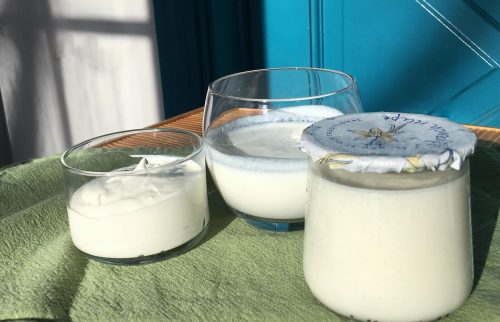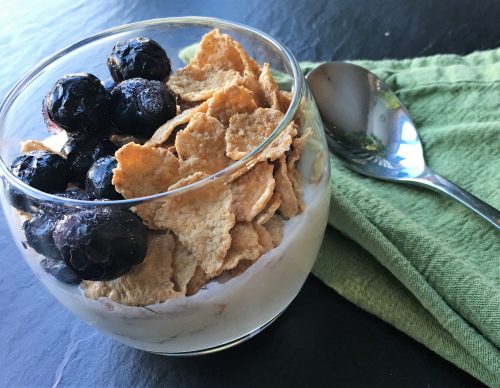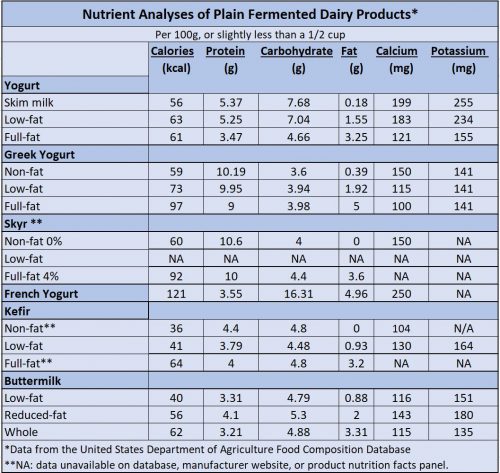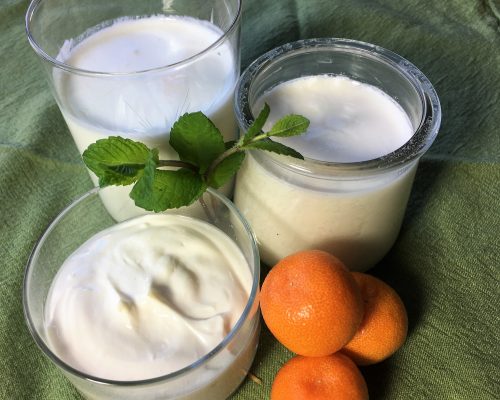This post was written by our former University of New Hampshire dietetic intern Jennifer Behymer, MS as part of a mini blog series on fermented dairy.
—
If you frequent the dairy aisle for more than just milk and cheese, you’ve likely seen numerous options of yogurt and fermented dairy products. Most may be familiar, but you may have noticed products such as kefir, skyr, and French style yogurt now sharing the shelves. While all fermented dairy products have potential benefits for GI health, it turns out they also differ in a number of ways. In this blog post we’ll explore how different fermented dairy products are made, how they vary nutritionally, and how they can be used on a daily basis.

Yogurt
Yogurt is made by heating milk (skim, low fat or whole) to a high temperature and then letting it cool to 110°F. Bacterial cultures, such as Lactobacillus bulgaricus and Streptococcus thermophiles are then added and the mixture is left to sit and ferment. This “incubation” period allows the yogurt to thicken, and the bacteria to consume the sugar in the milk (part of the fermentation process). Once thickened, the yogurt is refrigerated. Here is a homemade yogurt recipe featured on Must Be The Milk.
Greek Yogurt
Greek yogurt is made in the same way as yogurt, but is strained after the fermentation period to remove the water (whey). This results in a thicker, creamier yogurt with a more concentrated protein content.
Skyr
Skyr (“skeer”) is a traditional fermented dairy product of Iceland, and it is gaining popularity in the United States. Skyr is made by heating skim or low-fat milk with a small amount of skyr from a previous batch, which provides the bacterial cultures. Once thickened, the whey is slowly drained leaving a thick, sour product that is more like a soft cheese. Skyr can contain more than 20 grams of protein in 1 cup with very little fat or added sugar.
French Style Yogurt
French style yogurt is made with whole milk and uses a process called “pot-setting.” In this process, the milk and yogurt cultures are placed in the container the yogurt will be sold in to ferment for eight hours. Because of its higher fat content, this yogurt has a richer texture.
Kefir

Kefir is a drinkable fermented dairy product made when kefir “grains” (a yeast and lactic acid bacteria culture which looks like cauliflower) are added to whole, reduced, or fat-free milk. The mixture is left to ferment at room or refrigerator temperature. Once thickened, the grains are separated from the liquid and can be used to make the next batch of Kefir. Read our blog post about making kefir at home for step-by-step instructions.
Buttermilk
Another drinkable fermented milk product that may be more familiar is buttermilk. This drink, better known as an ingredient in biscuits or pancakes, is the liquid that is left-over liquid after making butter. Fermentation occurs in buttermilk through “ripening”, or allowing the liquid to sit before churning the butter. Buttermilk is often pasteurized, and healthy bacteria such as Lactobacillus acidophilus is added to ferment the remaining sugars, giving it its sour or tangy flavor.
Nutrition
Below is a table comparing the nutritional composition of the fermented dairy products discussed above.

Best Ways to Use
Any of these fermented products are great to have by themselves, or in recipes as substitutes to help boost nutrient content and lower fat in some cases. Due to their thinner consistency, kefir and buttermilk can be good substitutes for dressings or marinades, such as a creamy Italian dressing. The texture of French style yogurt lends itself to being a good substitute for mayonnaise in dips and salads. Yogurt and Greek yogurt is better suited to replace ingredients such as sour cream in dips. For more yogurt substitution ideas check out our guide.

No matter which fermented dairy product you decide to use, you are sure to get a healthy serving of good bacteria, protein, calcium, and a number of other vitamins and minerals. Stay tuned for another post on how to include prebiotics with your probiotics for more health benefits!
